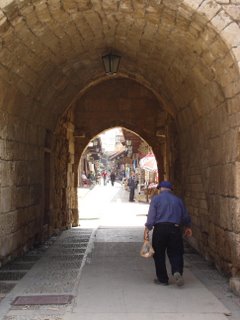Before the first bus trip to the valleys, we found out that, due to the bombing in south Lebanon, we would not be going to Sidon on Thursday. That would have included a visit to a glass blowing factory and opportunity to purchase some handblown glass. I was really looking forward to that. BUT, it was not to be. Some of our group wanted to go to a town called Byblos, north of Beirut, because they still have souks (bazaars), but the reunion group had gone there last year, and the school felt that they didn't want to subject them to a repeat trip.
The little group I am hanging out with (Lynn and Gail Hill and myself) decided that instead of attending the lectures and movies at the school yesterday, we would hire a car to take us to Byblos. We were all very disappointed to find out that the souks of Beirut, labarynthine and fascinating, no longer exist. It is fun to bargain and buy locally made items, so we wanted to go to Byblos for some haggling. Lynn and Gail had paid a local taxi driver to take them to the mountains a few days previously. Because he had proven to be reasonably priced and a safe driver (an oxymoron in Beirut), we chose him for our outing to Byblos.
We traveled the six lane highway again, the one that turned into a mass free-for-all, and then headed out to the rural areas. The terrain by Byblos is mildly hilly. Many people own a piece of land with their homes. Some have multiple greenhouses filled with citrus trees, tomatoes, or eggplant, and others have acres of banana trees. Byblos is as I remember: The fortress overlooks the water.
The souks are made up of alleyways with the shops tucked into the old walls of the town. Because we were there in the mid morning, there were not many people walking the streets and the shop-keepers were glad to see us. They all tried to get us to buy their wares. Mostly, we were interested in shawls, tablecloths, hubbly bubblies (hookas), and pillow covers. Many of the shops also sold antiquities and old coins that supposedly came with certificates of authenticity. How could the government of Lebanon let them be sold? Maybe they just have so many. (Alan Whitman, a former ACSer, has since assured me that Byblos is famous for its fake coin industry.)
We wandered down an alley where we noticed several fossil shops. At the one at the end, there was a large display of privately owned fossils preserved in sandstone. The owner invited us in for a demonstration on how they discover and uncover the fossils. Apparently, this is the only place in the world where some of these creatures can be found. His family has owned the land for three generations and they work with the Lebanese government to preserve the fossils for posterity. He had a copy of an article from a French version of National Geographic that showed photos of some of his collection. Also, the book of fossils that he had on hand had many pictures of his personal specimens and they mentioned that they are found in Lebanon. Most of them were millions of years old. He had an octopus fossil, a small turtle, many sharks and flying fish. A large shrimp fossil was especially interesting.
Once we had made our purchases, one of the shopkeepers (who had especially benefitted from our shopping experience) suggested a small restaurant north of town situated on a bluff. Our driver took us out there and we had a lovely Arabic lunch overlooking the harbor and the Mediterranean. Little did I know that my tummy might not like it so much later... :-(
We made our way back to Beirut through the gauntlet of no-lane pandemonium and were deposited at our hotel by mid afternoon. All in all, a good days haul!
The school scheduled an Arabic feast for that evening at a place down on the Corniche (a walk-way all along the sea front), so our hotel groupies all hiked on down there just as the orb of the sun was setting, red with yellow stripes. Unfortunately, my camera didn't capture the full effect, but it was beautiful.
A couple of our school chums who live in Beirut, and whom we had not seen yet, joined us for the dinner. One, Alice Ludvigsen, has married a Lebanese, and they have a pub and restaurant uptown, called "The-By-The-Way Pub." It is fairly near our hotel, so when we walked back up the hill after dinner, we stopped in to meet Ahmed, Alice's husband. They have a lovely story about how they met, which I will share with you at some point.
Today is Thursday and I should be on another field trip to the grotto and lace making factory. As I woke up with a questionable tummy, I have decided to sit this one out. I have shawarma to eat yet so I need to get my digestion in good condition by tomorrow. As my friend, Lynn, says, we are eating our way through the Middle East! In addition, I am eating my way through Cyprus, too.
It's a tough job, but somebody's got to do it!
Subscribe to:
Post Comments (Atom)






.jpg)
1 comment:
Post a Comment